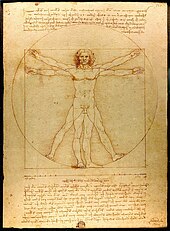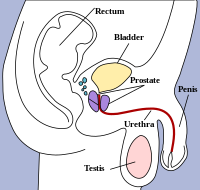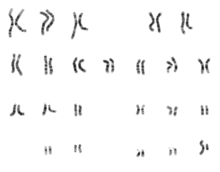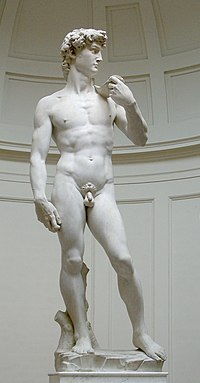رجل: الفرق بين النسختين
| [مراجعة غير مفحوصة] | [مراجعة غير مفحوصة] |
←الذكورة: تعقيب يوجد نص e وسم: تعديل في تطبيق الأجهزة المحمولة |
وسم: تعديل في تطبيق الأجهزة المحمولة |
||
| سطر 62: | سطر 62: | ||
تحفز الإندروجينات ولاسيما التيستيستيرون نمو الأعضاء الجنسية المشتركة في الجنين غير المحدد الجنس ثم تحفز نمو الأعضاء التي ستصبح للذكر كالقضيب [[أنبوب ولفي|والأنبوب الولفي]] (Wolffian ducts) و<nowiki/>[[تلافيف خصوية|التلافيف الخصوية]] (Labioscrotal folds). |
تحفز الإندروجينات ولاسيما التيستيستيرون نمو الأعضاء الجنسية المشتركة في الجنين غير المحدد الجنس ثم تحفز نمو الأعضاء التي ستصبح للذكر كالقضيب [[أنبوب ولفي|والأنبوب الولفي]] (Wolffian ducts) و<nowiki/>[[تلافيف خصوية|التلافيف الخصوية]] (Labioscrotal folds). |
||
== الذكورة |
== الذكورة== |
||
{{مفصلة|ذكورة}} |
{{مفصلة|ذكورة}} |
||
{{See also|صورة نمطية}} |
{{See also|صورة نمطية}} |
||
نسخة 02:16، 31 أغسطس 2016

الرجل هو ذكر الإنسان البالغ، في مقابل المرأة وهي أنثى الإنسان البالغة، وتستخدم الكلمة لتمييز الفرق الحيوي (البيولوجي) بين أفراد الجنسين أو للتمييز بين الدور الاجتماعي لكليهما في الثقافات المختلفة.
الرجل أو الامْرُؤ أو المَرّء عادة ما تستخدم كألفاظ للدلالة على الذكر البالغ، حيث تستخدم ألفاظ أخرى للدلالة على ذكر الإنسان غير البالغ منها ولد وصبي وغلام.
أما الرجولة فسيولوجياً فهي اكتمال نمو ذكر الإنسان واكتسابه خصائص مميزة من أهمها:
- ظهور اللحية والشارب.
- نمو شعر الجسم على الصدر والأذرع والأرجل وحول الأعضاء التناسلية.
- تغير الصوت نحو الخشونة.
- زيادة في طول القامة.
- بدء القدرة على التخصيب وإنتاج الحيوانات المنوية.
يمتلك الرجل كروموسوم x من أمه وكروموسوم y من أبيه وهي صفة مشتركة مع جميع الذكور من الثدييات الأخرى، يفرز الجنين الذكر عند الإنسان هرمون الأندروجين بنسبة أكبر من هرمون الإستروجين بالمقارنة مع الجنين الأنثى؛ فنسبة الفرق والتباين في إنتاج الستيرويدات الجنسية بين الجنينين هي التي تحدد نوع الجنين ذكراً كان أم أنثى، مع وجود احتمال أن يكون الجنين ثنائي الجنس (Intersex) أو متحوِّلاً (Transgender).
المصطلح
الرَّجُلُ ضد المرأة والجمع رِجالٌ، ورِجالاتٌ مثل جِمال وجِمالات وأَرَاجِلُ ويقال للمرأة رَجُلَة كقولك كانت عائشة رَجُلَةَ الرأي، وتصغير الرجل رُجَيْلٌ، ورُوَيْجِلٌ أيضاً على غير قياس كأنه تصغير راجل؛ والرُّجْلَةُ بالضم مصدر الرجل والراجل والأرجل يقال رجل بين الرُّجْلَةِ و الرُجُولةِ و الرُّجُوليَّةِ و رَاجِلٌ جيد الرُّجْلَةِ [1].
والرجل تطلق عامة على بعض الفئات كقولك، رجل الأعمال، ورجل الساعة، ورجل الدولة، ورجل المطافئ، ورجل الدّينِ، ورجل الشارع، ورجل الشرطة، ورجل الفضاء، ورجل العمل، وكقولك فلان من رجالات قومه أي من كبارها وسادتها وعظمائها [2][3].
يقال هذا أَرْجَلُ الرَّجُلَيْن أي أكملهما، والرجل أحياناً يعرَّف به مطلق الإنسان [3].
العمر والمصطلح
يستخدم المصطلح رُجُولَة لوصف الحالة العمرية بعد الطفولة بما في ذلك المرحلة الأخيرة من فترة البلوغ، حيث تظهر المعالم الجنسية الثانوية على الشخص، كتفاحة آدم وشعر الوجه. والمصطلح بحد ذاته مرتبط بمعاني الفحولة (virility)، والذكورة (masculinity)، وله متطلباته الاجتماعية.
البيولوجيا والجنس
يُظهِر الإنسان تبايناً كبيراً في المظهر الخارجي لكلا الجنسين، ويكمن الفارق الأساسي بينهما في الوزن والطول والبنية الجسمية؛ ومن أهم هذه المظاهر التي تميز الذكر عن الأنثى:
- شعر عانة أكثر
- شعر وجه أكثر
- يدان وقدمان أكبر
- أكتاف أعرض وصدر أوسع
- جمجمة وعظام أكبر
- دماغ أكبر حجماً ووزناً
- كتلة عضلية أكبر
- تفاحة آدم أكبر وصوت أعمق
- طول أكثر
- نسبة طول أكبر بين عظمة الفخذ وعظمة الساق.
المعالم الجنسية

يتم تحديد الملامح الجنسية لكلا الجنسين البشريين الذكر والأنثى؛ عند تخصيب البويضة في رحم الأم بالحيوان المنوي القادم من الأب، فإذا اقترن كروموسوم X من الأب وكروموسوم X من الأم تكون النتيجة تكون جنين أنثى (XX)، في حين لو اقترن كروموسوم Y من الأب وكروموسوم X من الأم، يتكون الجنين ذكراً (XY). علماً أن الأم لا تعطي إلا كروموسوم X دائماً، بينما يعطي الأب الكروموسوم X، أو الكروموسوم Y. ولكن يحدث أحياناً أن يندمج أكثر من كروموسومين في نفس الخلية المخصَّبة، واحتمالاتها العلمية كثيرة هي X (متلازمة تيرنر)، XXY (متلازمة كلاينفيلتر)، XYY (متلازمة XYY)، XXYY (متلازمة XXYY)، XXX (متلازمة XXX)، XXXX (متلازمة XXXX)، XXXXX (متلازمة XXXXX).
تنتج الغدد الجنسية الجاميت اللازم للتخصيب حيث تنتج المبايض في الأنثى البويضات وتنتج الخصيتان في الذكر الحيوانات المنوية، واتحاد هذين المُنْتَجَيْن يحدد المعالم الجنسية الأولية للجنين. في حين تحدد المعالمَ الجنسية الثانوية عواملُ أقل حسماً في تكوين الجنين، وهذه العوامل جينية في الغالب حيث تشمل كل شيء كفوارق بين الذكر والأنثى من مثل الريش الزاهي لذكور الطيور، إلى شعر الوجه عند البشر، إلى السمات السلوكية في كل نوع كالمغازلة الجنسية.
الجندر
لتحديد جنس شخص ما لا يمكن للعوامل البيولوجية وحدها أن تقوم بهذا. فهناك رجال متحولون جنسياً أو رجال متحولون جندرياً، وهم المعرَّفون عند الولادة كإناث، ولكنهم يتصرفون كذكور. ويترتب على هذا الأمر عدة قضايا اجتماعية وقانونية ودينية.
الجهاز التناسلي

الأعضاء التناسلية للذكر تشمل القضيب، والخصيتين، والأسهر، وغدة البروستات. ومهمتها إنتاج السائل المنوي الذي يحمل الحيوانات المنوية والمعلومات الجينية التي تتحد مع البويضة في رحم الأنثى، لتكوين الجنين. حيث ينتهي دور الذكر تماماً عند تخصيب البويضة ولا يلعب أي دور إطلاقاً خلال جميع مراحل الحمل اللاحقة.
هناك بعض المصطلحات الاجتماعية المرتبطة بهذه العملية (التخصيب والحمل والولادة)، هي الأبوة والأسرة.
بدعى العلم المتخصص بدراسة الجهاز التناسلي الذكري بطب الذكورة (Andrology).

الهرمونات الجنسية
تحفز الإندروجينات ولاسيما التيستيستيرون نمو الأعضاء الجنسية المشتركة في الجنين غير المحدد الجنس ثم تحفز نمو الأعضاء التي ستصبح للذكر كالقضيب والأنبوب الولفي (Wolffian ducts) والتلافيف الخصوية (Labioscrotal folds).
الذكورة

Masculinity has its roots in genetics (see gender).[5][6] Therefore, while masculinity looks different in different cultures, there are common aspects to its definition across cultures.[7] Sometimes gender scholars will use the phrase "hegemonic masculinity" to distinguish the most dominant form of masculinity from other variants. In the mid-twentieth century United States, for example, جون وين might embody one form of masculinity, while ألبرت أينشتاين might be seen as masculine, but not in the same "hegemonic" fashion.
Machismo is a form of masculine culture. It includes assertiveness or standing up for one's rights, responsibility, selflessness, general code of ethics, sincerity, and respect.[8]
Anthropology has shown that masculinity itself has social status, just like wealth, race and social class. In western culture, for example, greater masculinity usually brings greater social status. Many English words such as virtue and virile (from the Indo-European root vir meaning man) reflect this.[9][10] An association with physical and/or moral strength is implied. Masculinity is associated more commonly with adult men than with boys.
A great deal is now known about the development of masculine characteristics. The process of sexual differentiation specific to the reproductive system of Homo sapiens produces a female by default. The SRY gene on the كروموسوم واي, however, interferes with the default process, causing a chain of events that, all things being equal, leads to testes formation, androgen production and a range of both pre-natal and post-natal hormonal effects covered by the terms masculinization or virilization. Because masculinization redirects biological processes from the default female route, it is more precisely called defeminization.
There is an extensive debate about how children develop هوية جندرية.
In many cultures displaying characteristics not typical to one's gender may become a social problem for the individual. Among men, the exhibition of feminine behavior may be considered a sign of homosexuality, while the same is for a woman who exhibits masculine behavior. Within sociology such labeling and conditioning is known as gender assumptions and is a part of socialization to better match a culture's mores. The corresponding social condemnation of excessive masculinity may be expressed in terms such as "machismo" or "testosterone poisoning."
The relative importance of the roles of socialization and genetics in the development of masculinity continues to be debated. While social conditioning obviously plays a role, it can also be observed that certain aspects of the masculine identity exist in almost all human cultures.
The historical development of gender role is addressed by such fields as behavioral genetics, evolutionary psychology, human ecology and sociobiology. All human cultures seem to encourage the development of gender roles, through literature, costume and song. Some examples of this might include the epics of هوميروس, the King Arthur tales in English, the normative commentaries of كونفوشيوس or biographical studies of محمد. More specialized treatments of masculinity may be found in works such as the البهاغافاد غيتا or bushido's Hagakure.
Culture and gender roles

Well into prehistoric culture, men are believed to have assumed a variety of social and cultural roles which are likely similar across many groups of humans. In hunter-gatherer societies, men were often if not exclusively responsible for all large game killed, the capture and raising of most or all domesticated animals, the building of permanent shelters, the defense of villages, and other tasks where the male physique and strong spatial-cognition were most useful.[بحاجة لمصدر] Some anthropologists believe that it may have been men who led the Neolithic Revolution and became the first pre-historical ranchers, as a possible result of their intimate knowledge of animal life.[بحاجة لمصدر]
Throughout history, the roles of men have changed greatly. As societies have moved away from agriculture as a primary source of jobs, the emphasis on male physical ability has waned. Traditional gender roles for working men typically involved jobs emphasizing moderate to hard manual labor (see عامل), often with no hope for increase in wage or position. For poorer men among the working classes, the need to support their families, especially during periods of industrial change and economic decline, forced them to stay in dangerous jobs working long arduous hours, often without retirement. Many industrialized countries have seen a shift to jobs which are less physically demanding, with a general reduction in the percentage of manual labor needed in the work force (see عمال الياقات البيضاء). The male goal in these circumstances is often of pursuing a quality education and securing a dependable, often office-environment, source of income.

The Men's Movement is in part a struggle for the recognition of equality of opportunity with women, and for equal rights irrespective of gender, even if special relations and conditions are willingly incurred under the form of partnership involved in marriage. The difficulties of obtaining this recognition are due to the habits and customs recent history has produced. Through a combination of economic changes and the efforts of the feminist movement in recent decades, men in some societies now compete with women for jobs that traditionally excluded women. Some larger corporations have instituted tracking systems to try to ensure that jobs are filled based on merit and not just on traditional gender selection. Assumptions and expectations based on sex roles both benefit and harm men in Western society (as they do women, but in different ways) in the workplace as well as on the topics of education, violence, health care, politics, and fatherhood - to name a few. Research has identified anti-male sexism in some areas which can result in what appear to be unfair advantages given to women.[بحاجة لمصدر]
The Parsons model was used to contrast and illustrate extreme positions on gender roles. Model A describes total separation of male and female roles, while Model B describes the complete dissolution of barriers between gender roles.[11] The examples are based on the context of the culture and infrastructure of the United States. However, these extreme positions are rarely found in reality; actual behavior of individuals is usually somewhere between these poles. The most common 'model' followed in real life in the United States and Great Britain is the 'model of double burden'.[بحاجة لتوضيح]
Exclusively male roles
Some positions and titles are reserved for men only. For example, the position of Pope and أسقف in the الكنيسة الرومانية الكاثوليكية. Also the priesthood is exclusively male in the Catholic Church and also some other religious traditions. Men are often given priority for the position of monarch (جورج كينغ in the case of a man) of a country, as it usually passes to the eldest male child upon succession.
See also
Medical:
Dynamics:
Political:
References
- ^ مختار الصحاح، مادة رجل
- ^ معجم الغني، مادة رجل
- ^ أ ب معجم اللغة العربية المعاصر، مادة رجل
- ^ The Vitruvian man
- ^ John Money, 'The concept of gender identity disorder in childhood and adolescence after 39 years', Journal of Sex and Marital Therapy 20 (1994): 163-77.
- ^ Laura Stanton and Brenna Maloney, 'The Perception of Pain', Washington Post, 19 December 2006.
- ^ Donald Brown, Human Universals
- ^ Mirande, Alfredo (1997). Hombres y Machos: Masculinity and Latino Culture, p.72-74. ISBN 0-8133-3197-8.
- ^ "Virtue (2009)". Merriam-Webster Online Dictionary. 2009. اطلع عليه بتاريخ 2009-06-08.
{{استشهاد ويب}}: يحتوي الاستشهاد على وسيط غير معروف وفارغ:|month=(مساعدة) - ^ "Virile (2009)". Merriam-Webster Online Dictionary. 2009. اطلع عليه بتاريخ 2009-06-08.
{{استشهاد ويب}}: يحتوي الاستشهاد على وسيط غير معروف وفارغ:|month=(مساعدة) - ^ Brockhaus: Enzyklopädie der Psychologie, 2001.
Further reading
- Andrew Perchuk, Simon Watney, bell hooks, The Masculine Masquerade: Masculinity and Representation, MIT Press 1995
- بيير بورديو, Masculine Domination, Paperback Edition, Stanford University Press 2001
- Robert W. Connell, Masculinities, Cambridge : Polity Press, 1995
- Warren Farrell, The Myth of Male Power Berkley Trade, 1993 ISBN 0-425-18144-8
- Michael Kimmel (ed.), Robert W. Connell (ed.), Jeff Hearn (ed.), Handbook of Studies on Men and Masculinities, Sage Publications 2004
External links
 - ويكاموس
- ويكاموس - ويكي اقتباس
- ويكي اقتباس- قالب:Commonsinline
مراجع
| في كومنز صور وملفات عن: رجل |
| ابحث عن رجل في ويكاموس. |
